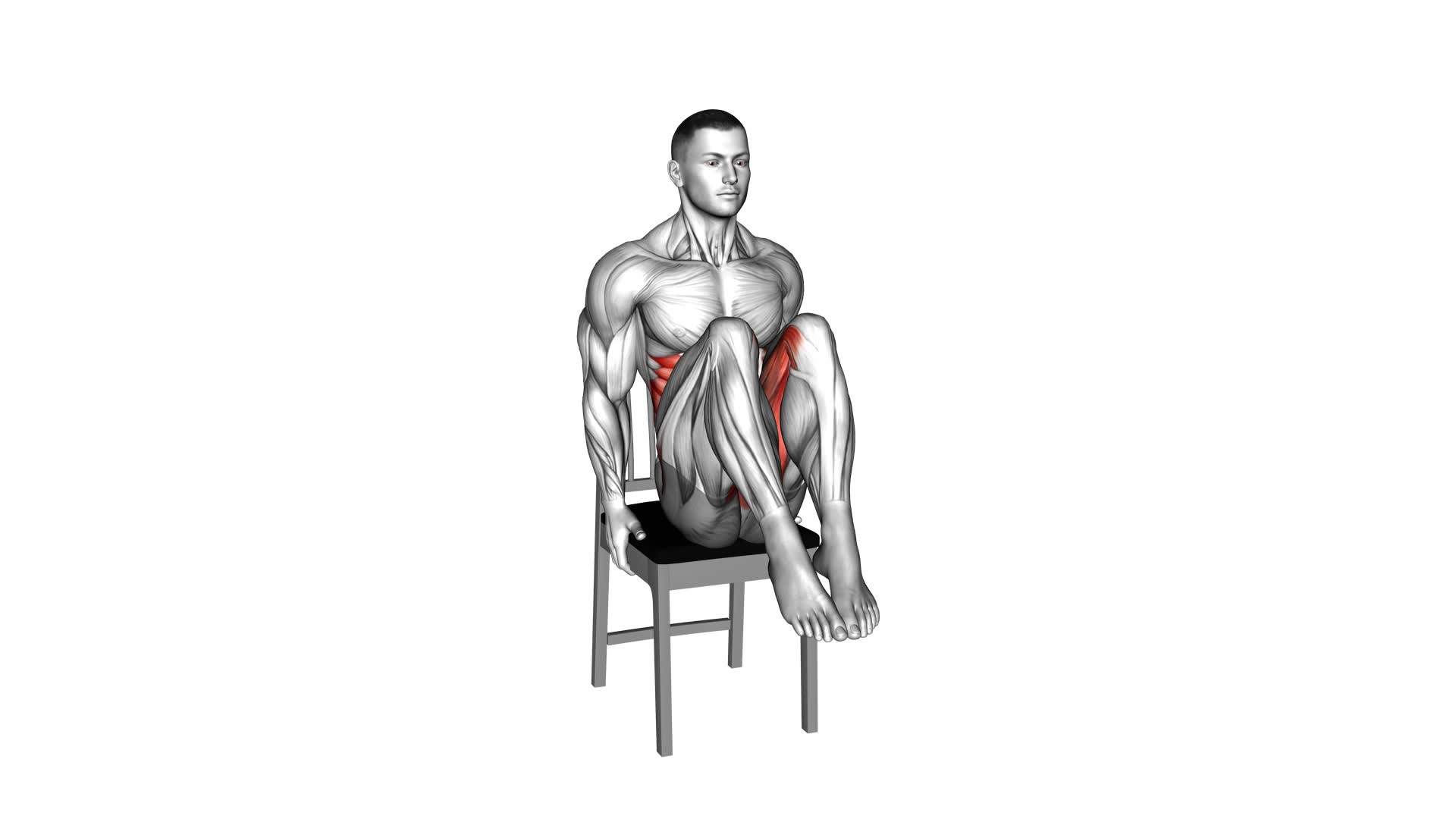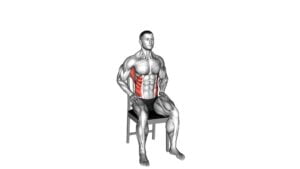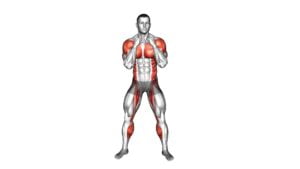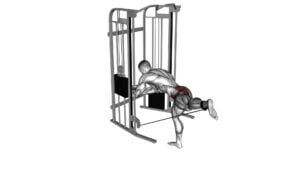Diagonal In Out on Chair (male) – Video Exercise Guide & Tips

Looking to level up your workout routine? Check out this video exercise guide and tips for the Diagonal In Out on Chair (male) exercise.
Watch This Exercise Video
This dynamic move targets your core, glutes, and legs, helping you build strength and stability. Learn the proper form and technique, discover variations and progressions to challenge yourself, and avoid common mistakes.
Get ready to sweat and achieve your fitness goals with this effective exercise. Let's get started!
Key Takeaways
- Diagonal In Out on Chair exercise increases core strength and improves stability.
- This exercise targets multiple muscle groups and enhances overall stability.
- Proper form and technique, such as maintaining a straight spine and engaging the core, are important for performing this exercise correctly.
- Common mistakes to avoid include leaning back too far, allowing legs to swing uncontrollably, and using too much resistance or weight.
Benefits of Diagonal In Out on Chair Exercise
Experience the numerous benefits of the Diagonal In Out on Chair exercise, including increased core strength and improved stability. This exercise isn't only effective in improving flexibility but also targets multiple muscle groups in your body.
The Diagonal In Out on Chair exercise primarily focuses on engaging your core muscles. By performing this exercise regularly, you can strengthen your abdominal muscles, obliques, and lower back. This increased core strength not only enhances your overall stability but also improves your posture.
In addition to core strength, the Diagonal In Out on Chair exercise also targets your upper and lower body muscle groups. As you move your arms and legs in a diagonal pattern, you engage the muscles in your shoulders, chest, and upper back. Simultaneously, your glutes, quadriceps, and hamstrings work to stabilize your lower body.
Moreover, this exercise helps in improving flexibility. The diagonal movements involved in this exercise stretch your muscles, increasing their range of motion. This can be particularly beneficial for individuals who struggle with tight muscles or limited flexibility.
Proper Form and Technique
To perform the Diagonal In Out on Chair exercise with proper form and technique, position yourself on the chair as described in the previous subtopic. Once you're in the starting position, it's important to maintain proper form to maximize the effectiveness of the exercise and minimize the risk of injury.
Here are some tips for beginners to ensure you're performing the Diagonal In Out on Chair exercise correctly:
- Keep your core engaged throughout the exercise to stabilize your body and maintain balance.
- Maintain a straight spine and avoid rounding your back.
- Keep your shoulders relaxed and away from your ears.
- Control your movements and avoid using momentum to swing your legs.
- Focus on using your abs and obliques to lift and rotate your legs, rather than relying on your hip flexors.
Common mistakes to watch out for when performing this exercise include:
- Leaning back too far and putting excessive strain on your lower back.
- Allowing your legs to drop or swing uncontrollably.
- Rushing through the exercise without proper control and form.
Equipment and Setup
To properly set up for the Diagonal In Out on Chair exercise, you'll need a sturdy chair and enough space to move your legs comfortably. This exercise is a great addition to your chair exercises routine, as it targets your lower body muscles and improves balance and coordination.
First, choose a chair that's stable and can support your weight. Make sure it's placed on a flat surface and doesn't wobble. Position the chair in an open area where you have enough space to move your legs freely without any obstructions.
Next, sit on the chair with your back straight and feet flat on the ground. Keep your knees bent at a 90-degree angle and your hands resting comfortably on your thighs. This is your starting position.
Now, lift your right foot off the ground and extend it diagonally outwards, away from your body. Slowly bring it back to the starting position. Repeat this movement with your left foot, extending it diagonally outwards and bringing it back.
Continue alternating between your right and left foot, performing the diagonal in and out motion. Remember to engage your core muscles and maintain good posture throughout the exercise.
With the equipment and setup in place, let's move on to the next section to explore variations and progressions of the Diagonal In Out on Chair exercise.
Variations and Progressions
Now let's explore some different ways you can progress and vary the Diagonal In Out on Chair exercise. Here are some variations and modifications you can try to make the exercise more challenging or adaptable to your fitness level:
- Increase the range of motion: Instead of just lifting your leg diagonally, try extending it fully to the side or even behind you. This will engage more muscles and provide a greater challenge.
- Add resistance: You can hold a dumbbell or a resistance band around your ankles to make the exercise more difficult. This will increase the resistance and work your muscles even harder.
- Incorporate balance challenges: Try performing the exercise on an unstable surface, such as a Bosu ball or a foam pad. This will require more core stabilization and improve your balance.
- Modify the speed: Slow down the movement to increase the time under tension and really focus on engaging your muscles. Alternatively, you can perform the exercise explosively to work on power and speed.
- Combine with other exercises: You can incorporate the Diagonal In Out on Chair into a circuit or superset with other exercises, such as squats or lunges. This will provide a full-body workout and keep your routine interesting.
Common Mistakes to Avoid
As you progress and vary the Diagonal In Out on Chair exercise, it's important to be aware of common mistakes to avoid. By understanding these common mistakes, you can ensure proper form and technique, which is essential for injury prevention.
One common mistake to avoid is using momentum instead of controlled movements. It's important to engage your core and focus on the muscles being worked. By using momentum, you not only decrease the effectiveness of the exercise but also increase the risk of injury.
Another mistake to avoid is rounding your back or hunching your shoulders during the exercise. This can put excessive strain on your spine and lead to back pain. Instead, focus on maintaining a neutral spine and keeping your shoulders relaxed and down.
Additionally, be cautious of using too much resistance or weight. Starting with lighter resistance and gradually increasing it as your strength improves is the best approach. Using too much weight can compromise your form and increase the risk of injury.
Lastly, avoid rushing through the exercise. Take your time to perform each repetition with proper form and control. This will ensure that you're effectively targeting the intended muscles and reducing the risk of strain or injury.
Tips for an Effective Workout
As you focus on proper form and technique to avoid common mistakes, it's important to incorporate these tips for an effective workout:
- Proper Breathing Techniques: Pay attention to your breath during the exercise. Inhale deeply before starting the movement and exhale as you exert force. This helps oxygenate your muscles and maintain stability throughout the exercise.
- Recommended Rep and Set Ranges: To maximize the benefits of the exercise, it's important to follow the recommended rep and set ranges. This ensures that you're challenging your muscles enough without overexerting yourself. Start with a weight or resistance level that allows you to complete 8-12 reps and 2-3 sets. As you progress, gradually increase the weight or resistance.
- Focus on Control and Range of Motion: Instead of rushing through the exercise, focus on maintaining control and a full range of motion. This helps engage the targeted muscles effectively and prevents injury.
- Warm Up and Cool Down: Before starting the exercise, make sure to warm up your body with dynamic stretches or light cardio to increase blood flow and prepare your muscles. After the workout, cool down with static stretches to improve flexibility and prevent muscle soreness.
- Listen to Your Body: Pay attention to any discomfort or pain during the exercise. If something doesn't feel right, modify the movement or consult a fitness professional for guidance. It's important to prioritize your safety and avoid pushing yourself too hard.
Frequently Asked Questions
How Many Calories Does the Diagonal in Out on Chair Exercise Burn?
The diagonal in out on chair exercise is a great way to burn calories and improve your fitness. This exercise targets your core, glutes, and legs, helping you build strength and tone your muscles. By incorporating this exercise into your routine, you can expect to burn a significant amount of calories.
To make the exercise easier or more challenging, you can modify the range of motion or add weights.
Can I Do the Diagonal in Out on Chair Exercise if I Have Knee Problems?
If you have knee problems, it's important to be cautious when doing the diagonal in out on chair exercise. This exercise can put strain on your knees.
Instead, focus on exercises that can help improve your knee strength without causing further discomfort. Some alternatives you can try include leg extensions, seated leg presses, and hamstring curls.
It's always best to consult with a medical professional or a certified trainer to ensure you're doing the right exercises for your specific knee condition.
How Often Should I Perform the Diagonal in Out on Chair Exercise?
To get the most out of the diagonal in out on chair exercise, it's important to know how often you should perform it. This exercise is great for targeting multiple muscle groups and improving overall strength and stability.
To modify it for beginners, you can start with smaller movements and gradually increase the range of motion.
As for the benefits, incorporating the diagonal in out on chair exercise into a full body workout routine can help improve balance, coordination, and core strength.
Can the Diagonal in Out on Chair Exercise Help With Improving Posture?
The diagonal in out on chair exercise is great for improving balance and strengthening your core. By incorporating this exercise into your routine, you can work towards better posture.
It targets your abdominal muscles, lower back, and hip flexors, all of which play a crucial role in maintaining good posture.
Consistency is key, so aim to perform this exercise regularly to see the best results.
Is the Diagonal in Out on Chair Exercise Suitable for Beginners?
The diagonal in out on chair exercise is a great choice for beginners. It helps strengthen your core and improve your stability. By incorporating modifications, you can tailor the exercise to your fitness level.
This exercise targets multiple muscle groups, including your abs, glutes, and legs. The benefits of the diagonal in out on chair exercise include improved posture, increased flexibility, and enhanced coordination.
Conclusion
In conclusion, the diagonal in out on chair exercise is a beneficial workout that targets the core muscles and improves stability.
By following proper form and technique, using the appropriate equipment and setup, and progressing with variations, you can avoid common mistakes and maximize the effectiveness of your workout.
Remember to stay focused and engaged throughout the exercise for optimal results.
Keep up the great work and enjoy the benefits of this challenging yet rewarding exercise.

Author
Years ago, the spark of my life’s passion ignited in my mind the moment I stepped into the local gym for the first time. The inaugural bead of perspiration, the initial endeavor, the very first surge of endorphins, and a sense of pride that washed over me post-workout marked the beginning of my deep-seated interest in strength sports, fitness, and sports nutrition. This very curiosity blossomed rapidly into a profound fascination, propelling me to earn a Master’s degree in Physical Education from the Academy of Physical Education in Krakow, followed by a Sports Manager diploma from the Jagiellonian University. My journey of growth led me to gain more specialized qualifications, such as being a certified personal trainer with a focus on sports dietetics, a lifeguard, and an instructor for wellness and corrective gymnastics. Theoretical knowledge paired seamlessly with practical experience, reinforcing my belief that the transformation of individuals under my guidance was also a reflection of my personal growth. This belief holds true even today. Each day, I strive to push the boundaries and explore new realms. These realms gently elevate me to greater heights. The unique combination of passion for my field and the continuous quest for growth fuels my drive to break new ground.







